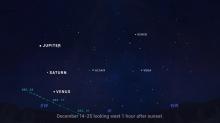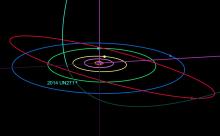Listen to today's episode of StarDate on the web the same day it airs in high-quality streaming audio without any extra ads or announcements. Choose a $8 one-month pass, or listen every day for a year for just $30.
You are here
Quadrantid Meteors
A meteor shower that may have a complex heritage should be at its best tonight. Unfortunately, the gibbous Moon is in the way for most of the night. Its glare will overpower all but the brightest meteors.
The shower was first seen a couple of centuries ago. It occurs when Earth flies through the orbital path of a comet or asteroid. The path is littered with small bits of dust and rock, which vaporize as they slam into Earth’s atmosphere.
Just which object is responsible for the Quadrantids remained a mystery for a long time. And even today, the subject isn’t necessarily settled.
Astronomers first associated the shower with a dead comet known as 2003 EH1. Later, they added Comet 96/P Machholz to the list.
A study a few years ago said that both bodies could be involved. In fact, they could share a parent — a larger comet that broke up about 9500 years ago. Over the millennia, the orbits of the two fragments moved apart — influenced in part by the gravity of the planets.
Today, the fragments follow different paths. One of them could account for the short, intense peak of the Quadrantids, which lasts for only about a day. The other could account for a more widely spread “drizzle” of meteors, which lasts for weeks.
The shower peaks before midnight tonight, but the best view may come in the hour or so before dawn, after the Moon sets — a brief window for a meteor shower with a complicated heritage.
Script by Damond Benningfield





